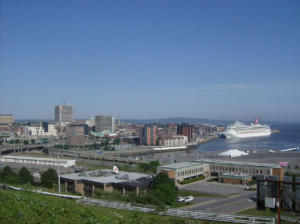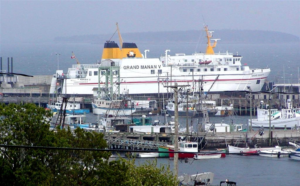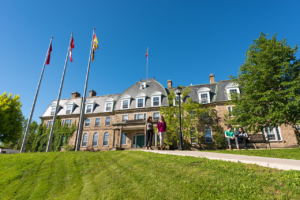
New Brunswick (French: Nouveau-Brunswick is one of the thirteen provinces and territories of Canada. It is one of the three Maritime provinces and one of the four Atlantic provinces. It is the only province with both French and English as its official languages.
New Brunswick is bordered by Quebec to the north, Nova Scotia to the east, the Gulf of Saint Lawrence to the northeast, the Bay of Fundy to the southeast, and the U.S. state of Maine to the west. New Brunswick is about 83% forested and its northern half is occupied by the Appalachians.
New Brunswick has a surface area of 72,908 km2 and 747,101 inhabitants (2016). Atypically for Canada, only about half of the population lives in urban areas. New Brunswick’s largest cities are Moncton and Saint John, while its capital is Fredericton.
The New Brunswick Legislative Building
New Brunswick’s climate is more severe than that of the other Maritime provinces, which are lower and have more shoreline along the moderating sea. New Brunswick has a humid continental climate, with slightly milder winters on the Gulf of St. Lawrence coastline. Elevated parts of the far north of the province have a subarctic climate.
Evidence of climate change in New Brunswick can be seen in its more intense precipitation events, more frequent winter thaws, and one quarter to half the amount of snowpack.

Photo: Uptown Saint John is a commercial hub and seaport for the province.
A large portion of the economy is controlled by the Irving Group of Companies, which consists of the holdings of the family of K. C. Irving. The companies have significant holdings in agriculture, forestry, food processing, freight transport (including railways and trucking), media, oil, and shipbuilding.
The United States is the province’s largest export market, accounting for 92% of a foreign trade valued in 2014 at almost $13 billion, with refined petroleum making up 63% of that, followed by seafood products, pulp, paper and sawmill products and non-metallic minerals (chiefly potash). A large number of residents from New Brunswick are employed in the primary sector of industry.
New Brunswick was in 2015 the biggest producer of wild blueberries in Canada. The value of the livestock sector is about a quarter of a billion dollars, nearly half of which is dairy. Other sectors include poultry, fur, and goats, sheep, and pigs.

Photo: Grand Manan V ferry at North Head
Fredericton International Airport (Greater Fredericton International Airport) is an airport in Lincoln, New Brunswick, southeast of Fredericton.
The Department of Transportation and Infrastructure maintains government facilities and the province’s highway network and ferries. The Trans-Canada Highway is not under federal jurisdiction, and traverses the province from Edmundston following the Saint John River Valley, through Fredericton, Moncton, and on to Nova Scotia and Prince Edward Island.
Via Rail’s Ocean service, which connects Montreal to Halifax, is currently the oldest continuously operated passenger route in North America, with stops from west to east at Campbellton, Charlo, Jacquet River, Petit Rocher, Bathurst, Miramichi, Rogersville, Moncton, and Sackville.
Canadian National Railway operates freight services along the same route, as well as a subdivision from Moncton to Saint John. The New Brunswick Southern Railway, a division of J. D. Irving Limited, together with its sister company Eastern Maine Railway form a continuous 305 km (190 mi) main line connecting Saint John and Brownville Junction, Maine.

Photo: Sir Howard Douglas Hall at the University of New Brunswick
Public education elementary and secondary education in the province is administered by the provincial Department of Education and Early Childhood Development. New Brunswick has a parallel system of Anglophone and Francophone public schools. In the Anglophone system, approximately 27 per cent of the students are enrolled in a French immersion programs.
There are eight chartered universities in New Brunswick; four public universities, governed by the Ministry of Post-Secondary Education, Training and Labor, and four private institutions including an online university, Yorkville University. New Brunswick holds the distinctions of having the first English-language university in Canada and the first public university in North America, (the University of New Brunswick);and also the first university in the British Empire to award a bachelor’s degree to a woman, (Mount Allison University) in 1875. St. Thomas University and University of New Brunswick have campuses in the province’s capital of Fredericton and UNB also maintains a campus in Saint John. Established in 1785, the University of New Brunswick is the oldest public in the province, and the Université de Moncton is the newest, formed in 1963, though dating back to 1864 through one of its three predecessor institutions. Public university enrolment ranges from Mount Allison University with 2,486 students to the University of New Brunswick with 10,587 students. Of the three private universities, Crandall University has an enrollment 800. Another private university, St. Stephen’s University is located in St. Stephen, NB. Kingswood University is an evangelical Christian University associated with the Wesleyan Church, located in Sussex, New Brunswick, Canada.
Colleges
Canadian School of Natural Nutrition
Collège communautaire du Nouveau-Brunswick
Eastern College
Maritime College of Forest Technology
McKenzie College
Moncton Flight College
New Brunswick College of Craft and Design
New Brunswick Community College
OLS Academy
Oulton College
Union of New Brunswick Indians Training Institute, Inc. (UNBITI)
Source of the majority of Photos and Content of this page: Wikipedia
It is your duty in life to save your dream
AMEDEO MODIGLIANI